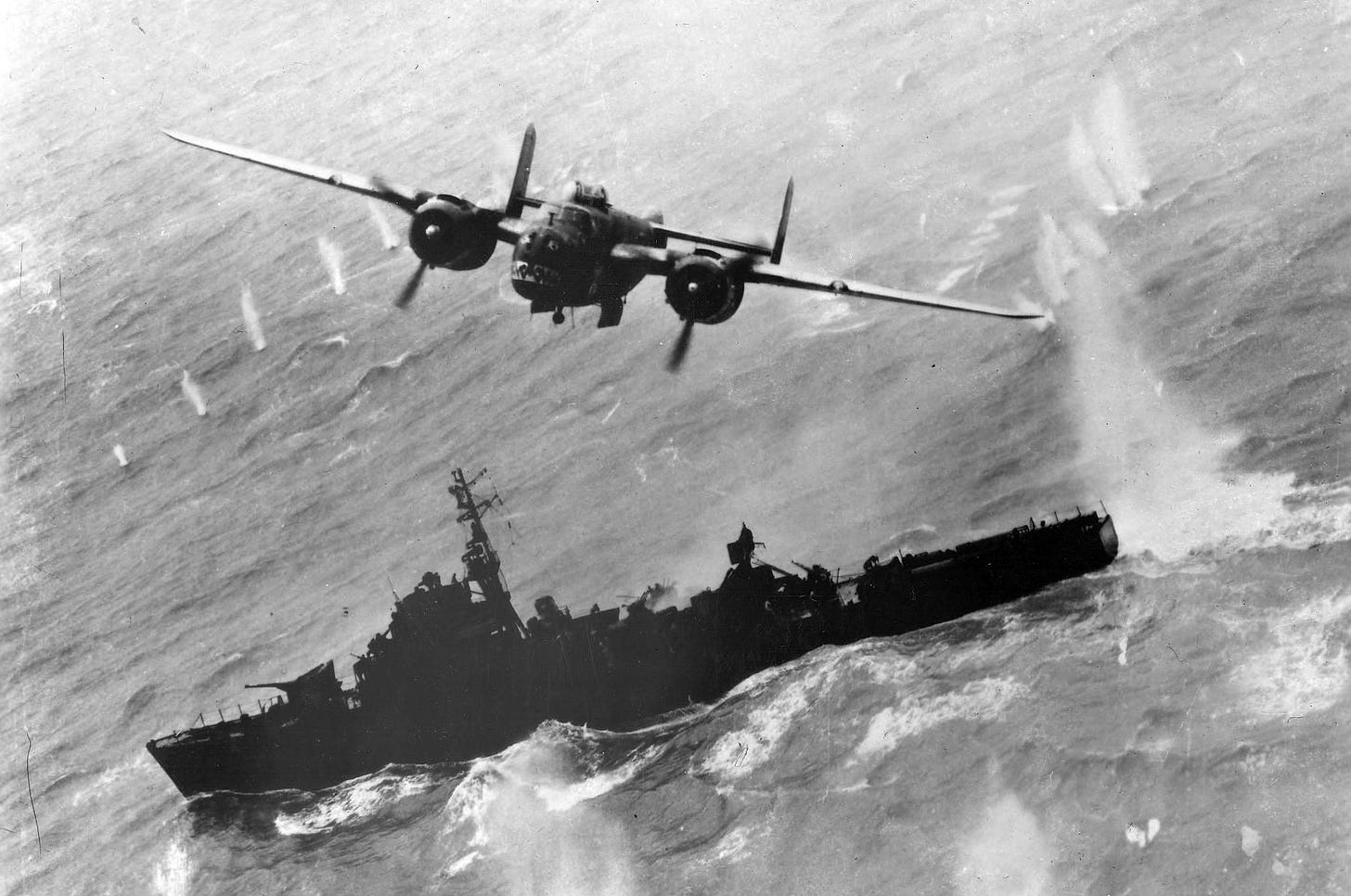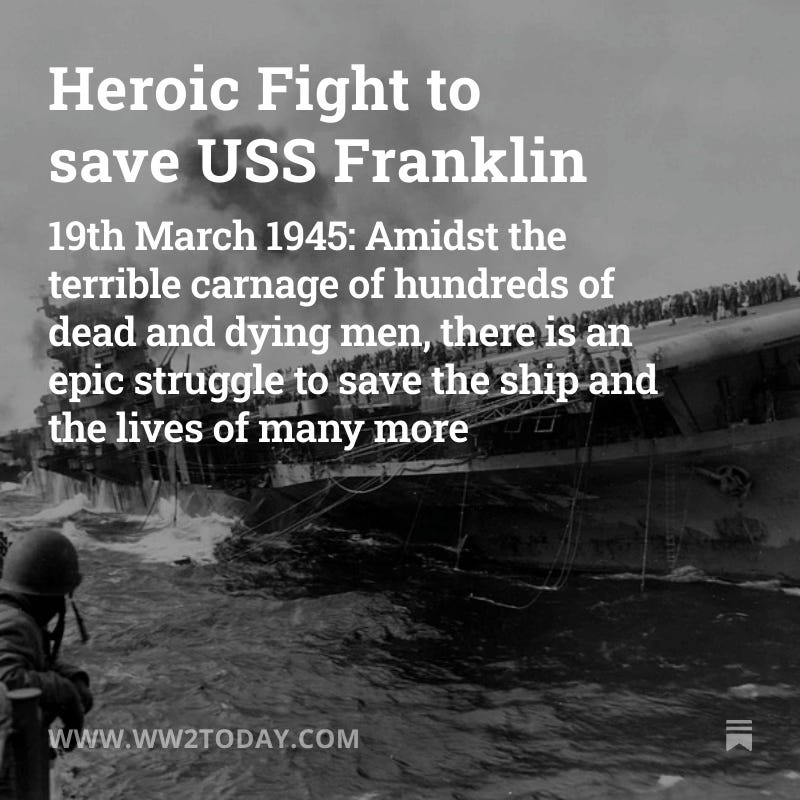'Jayhawk'
Flying B-25s bombers against the Japanese - all the hazards of combat plus the challenges of an unforgiving and remote environment
Former Marine fighter pilot and combat veteran Jay Stout has written several well-received books about American aviators, both in modern times and from World War II. He uses his experience to put the reader in the cockpit for a realistic portrayal of the everyday missions for pilots at war.
In Jayhawk: Love, Loss, Liberation, and Terror Over the Pacific he teamed up with Pacific war veteran George L Cooper. This is a vivid reconstruction of flying B-25s against the Japanese:
“I never liked to bomb from medium altitude,” George said. “For the actual bomb run, you had to turn control over to the bombardier and follow his directions while he used the bomb sight to fine-tune the drop onto the target. I always felt like a sitting duck, with nothing to do but get shot at. We couldn’t maneuver to get out of the way of fighters or flak because it would destroy the bombing solution.” Of course, getting bombs on target was the entire reason for the 345th’s existence at that point, so he and his crew really had no choice but to buckle down and endure it.
This grim reality was driven home on July 13, 1943. On that day, the 499th sent nine B-25s aloft, together with nine aircraft each from the rest of the group’s squadrons, and another squadron from the 38th Bomb Group. The target was a set of antiaircraft gun emplacements at MacDonald’s Junction, near Salamaua on New Guinea’s northeast coastline.
Considering the obvious fact that the guns were purpose-made to knock down aircraft such as the B-25, the mission was akin to a herd of elephants attacking a group of hunters armed with elephant guns. Someone was going to get hurt.
George was flying Jayhawk on the right wing of Alden Thompson who was leading the squadron that day at the controls of his ship, Jelly Belly. On Thompson’s left wing was Jack George and his crew. The morning takeoff was normal and Thompson made a wide circle around Durand while the rest of the squadron’s aircraft took off and joined the formation. That done, Thompson rendezvoused the squadron with the rest of the group as it took up a heading for Dobodura.
The group droned in circles over Dobodura waiting for an escort of fighters that was 30 minutes late. The leg to Salamaua was unremarkable other than that it was the first combat sortie for a few of the crews which created at least some degree of anxiety. The weather was spotty with layers of broken clouds here and there, and some of the squadrons lost sight of others as they readied for their separate runs on the target at an altitude of 10,000 feet.
Thompson, with George Cooper and Jack George on his wings, and two other three-ship formations in trail, made a couple of spacing turns in order to deconflict with the other squadrons and to hit the target at the prescribed time. Overhead, the escort of P-47s went without trade; there were no enemy fighters in sight.
Finally, Thompson rolled out on course for the target. George ordered the bomb bay doors open and felt Jayhawk shudder as they came apart and exposed the payload of bombs to the environment. Ahead of him there appeared a heavy barrage of antiaircraft fire, or flak. Bright orange bursts gave way to oily black smudges that dissipated slowly even as new bursts appeared. “On the earlier missions,” said George, “the Japs had missed low or high, but this time, they got our altitude right.”
“I didn’t like that,” he said. “I hated flying straight into that flak.” The antiaircraft fire increased in intensity as Thompson’s aircraft—at the head of the 499th—approached the release point. And then, just as bombs from the previous squadron exploded on the target, Jelly Belly reached that perfect three-dimensional point in the sky at which its bombs—if released—would strike the target. And indeed, at that very instant, Jelly Belly’s bombs fell clear.
The bombs from Jayhawk and Jack George’s aircraft likewise dropped earthward. “Just at that moment,” said George, “there was a sharp crack and a chunk of shrapnel came up through Stevens’ seat and smashed into his handheld computer.” Ralph Stevens, the bombardier, had earlier set his E6B “whiz wheel” on his seat before kneeling at the bomb sight. “He seemed pretty upset and shouted that, ‘the bastards shot my computer,’” said George. “I told him that he ought to be glad he hadn’t been sitting down—he might not have been able to complain. In truth, he would have been dead.”
While Stevens was reconsidering his luck, George saw that Alden Thompson and Jack George had not been nearly so fortunate. Jelly Belly was hit in the right wing between the engine and the fuselage; the engine nacelle caught fire. George had a front row seat from where he was flying, only about 50 feet from the stricken aircraft’s right wing. “Thompson was feathering his right engine,” he said, “and there was a fire going behind him in the navigator’s compartment where Lawrence Davis was. George Cagle, his copilot, was out of his seat and fighting the fire. And John Yarborough, the bombardier, had crawled through the tunnel under the cockpit from his position in the nose, and up to the navigator’s compartment. I could see that there was something wrong with him—he was wounded.”
In fact, Yarborough had been hit in the face and one of his eyes was knocked out of its socket. “Cagle went back to his seat,” said George, “while Yarborough, horribly injured, fought the fire. At about that time, the left engine also went dead.” From that point, Jelly Belly was little more than a poorly flying glider. And it was afire.
“While all this was going on,” said George, “Jack George had also been hit.” In fact, Jack George’s ship had been hit in both engines, the Plexiglas in the top turret was blown away, and the bombardier had nearly been hit by a piece of shrapnel that ripped through the compartment. With two sick engines, Jack George slid his aircraft out of the flight and back toward Port Moresby. “I throttled back to stay with Thompson,” George said.
He and his copilot, Bill Parke, and the rest of the crew, watched as the other aircraft’s nose dropped steeply toward the water in order to maintain flying speed. Closer to the water, George brought Jayhawk into level flight as Thompson lifted Jelly Belly’s nose and eased its descent toward the waves. “The water was rough and they hit pretty hard and threw up a lot of water,” George remembered. “The aircraft broke into two pieces behind the wings.”
George added power and circled the downed crew. He counted five men in the water. Although he didn’t know it, Yarborough, who had so bravely battled the fire in the navigator’s compartment—despite the injuries to his face and eye—failed to escape the sinking aircraft. “I stayed pretty low over them, and told the crew to watch out for sharks. I instructed them to shoot any sharks they saw.” Although sharks were a real danger, none were spotted.
Thompson had put his aircraft down several miles from shore at a point that was a couple of miles behind the Japanese lines. George marked the position and struck out for the coast on the Australian side of the lines. There he found an Australian Army encampment over which he flew at very low altitude and wagged his wings. “I made several passes and dropped a message telling them that there was an American crew out there. In truth, Thompson had gone down close enough to shore that there was a good chance that they had seen him.”
George wheeled Jayhawk back out to sea to check on his squadron mates. He spotted them again and rocked his wings. No doubt they drew some comfort at the sight of the B-25, knowing that someone was aware of their location and plight. On the other hand, George worried that the Japanese might take a cue from where he was flying and send a boat to investigate.
He pointed his aircraft back to the Australian position again. There, he could see a handful of soldiers helping some natives to push a pair of dugout canoes through the breakers that crashed onto the beach. They had no success—the waves were too big. Frustrated and worried about his friends, but low on fuel, George turned for home and started a gentle climb.
Still far from shore, Thompson and his crew, buoyed by their Mae West lifejackets, clung to each other and paddled slowly toward shore. Their progress was hampered as they nursed the navigator, Lawrence Davis. Both of his legs were nearly cut off below the knee and after several hours he died, likely from shock and loss of blood. His comrades had little choice but to let him slip beneath the surface and leave him behind.
Jack George made it safely back to base, as did George and the crew of Jayhawk. When the 345th’s deputy commander, Clinton True, learned that Thompson’s crew had gone down, he ordered an extra life raft loaded aboard a B-25 and took off for Salamaua without any sort of escort. There, he searched the waves but his efforts went unrewarded; he failed to spot them. They were in fact still swimming to shore and saw him, but had nothing with which to signal, and could do little more than wave when his aircraft came near.
© Jay A. Stout and George Cooper 2020, Jayhawk: Love, Loss, Liberation, and Terror Over the Pacific. Reproduced courtesy of Casemate Publishers.





